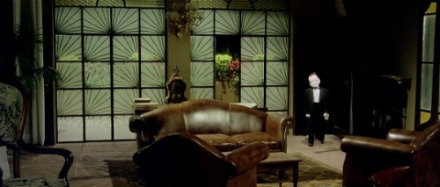Profondo Rosso (Deep Red) (1975)
DIRECTED BY Dario Argento
RUN TIME 126 min.
STARRING: David Hemmings (Marcus Daly), Daria Nicolodi (Gianna Brezzi), Gabriele Lavia (Carlo), Macha Méril (Helga Ulmann), Eros Pagni (Supt. Calcabrini)
What is left be said about Argento’s
Profondo Rosso?
It feels almost cliché to say that it’s one of the very best the genre ever produced. That it’s visually stunning, expertly composed and even – for one of the few times in Argento’s career – has a strong screenplay (by Argento and frequent Fellini collaborator Bernardino Zapponi). The set pieces are bigger and the murders bloodier than ever before – and the subtle supernatural overtones cleared a path for Suspiria (1977), it’s perhaps Argento’s masterpiece and the film that would go on to define his career. But it’s also a supremely satisfying film, so overflowing with style that an unprepared viewer can almost be overwhelmed by the cavalcade of visual and aural stimuli on display.
I’m almost embarrassed to say that my recent viewing of the film was my first time experiencing the International version of the film after struggling through the severely edited version (known as The Hatchet Murders) that floated around the public domain throughout the 90s. That version snips over twenty minutes of graphic violence and – equally important – exposition and character development, making a viewing of the complete version a totally different (and much more rewarding) experience.
For fans of giallo cinema, or even just those familiar with Argento’s “animal trilogy” of films (The Bird with the Crystal Plumage (1970), The Cat o’ Nine Tails (1971) and Four Flies on Grey Velvet (1972)), much of the plot will seem strangely familiar. David Hemmings (from Michelangelo Antonioni’s Blow-Up (1966), itself a proto-giallo) plays Marcus Daly, a Jazz musician teaching in Italy who finds himself in the middle of a murder mystery after witnessing his downstairs neighbour brutally murdered by a black-gloved maniac. Suspected by the police and plagued with the suspicion that he witnessed a clue that he can’t remember, Marcus teams with reporter Gianna (Argento regular Daria Nicolodi) to help track down the killer. What follows are a series of murders – my favorite being a bizarre attack featuring a walking a terrifying robotic doll – punctuating each step as the pair grow closer to learning the truth.
These murder set pieces are some of the most stylized and inventive in the genre, and their influence would be felt in the kill-happy slasher films which would soon be following. Argento’s floating, snaking camera is like another character, and occasionally seems to have a mind of its own as it switches seamlessly between first-person impressions of the killer to hyper stylized shots of the surroundings. Superb Cinematography (by Luigi Kuveiller, who went on to work with Lucio Fulci in The New York Ripper (1982)) mixes with Argento’s usual fascination with bold primary colors to create a terrifying funhouse thrill ride, which never forgets that its primary goal is to scare the audience.
Even the acting seems to be a step above the norm with Hemmings a sympathetic, if passive and misogynistic, partner to the confident and capable Nicolodi. They make for a fun pair, and their flirty interactions (excised nearly totally from the US version) add some much needed levity to a film that is already overflowing with bloodshed. Equally strong is Gabriele Lavia as the self-destructive homosexual (and obvious mirror of Marcus) Carlo. While performances are, as usual, hurt a bit by the necessary post-synced sound – an issue exacerbated by the fact that much of the “new” footage never had an English soundtrack – the performers still anchor the overdose of style in some measure of reality.
And we can’t forget the music! Prog rock pioneers Goblin would go on to great acclaim with their Suspiria score, but their work here is equally as good – and perhaps even better. The main theme (which plays over the opening credits and repeatedly throughout the rest of the film) is renowned, but even the more understated compositions add beautifully to the tension. In fact, the whole soundscape is simply another part of the stylized nature of the film, including the children’s song that the murderer plays to set the stage for their brutality.
Psychologically fascinating, and filled to the brim with brilliantly staged scenes of tension and terror, Deep Red remains my favorite of Argento’s giallo films, and might very well be my favorite of his entire output. It strikes a perfect balance of Hitchcockian suspense and stylish bloodshed, while putting a neat ribbon on a genre that he helped popularize – while still maintaining the tropes of early efforts like Mario Bava’s The Girl Who Knew Too Much (1963) and Blood and Black Lace (1964). A neat package all around, and one that deserves to be in the collection of any serious fan of horror cinema.
Sweetback
- [THE BIG QUESTION] WHAT’S YOUR FAVORITE FEMALE ENSEMBLE IN MOVIES? - July 22, 2016
- [IN THEATERS NOW] THE BOY (2016) - January 24, 2016
- Cult Movie Mania Releases Lucio Fulci Limited Edition VHS Sets - January 5, 2016








No Comments